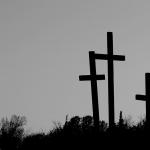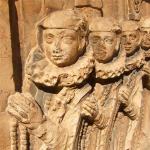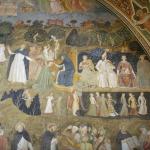While it is true that humanity has been made in the image and likeness of God, I have always found it difficult to believe that this is true only for humanity. I admit, it is the assumption of many, and this is what we find in the majority of Christian literature. The Catechism of the Catholic Church itself suggests this:
“God created man in his own image, in the image of God he created him, male and female he created them.” Man occupies a unique place in creation: (I) he is “in the image of God”; (II) in his own nature he unites the spiritual and material worlds; (III) he is created “male and female”; (IV) God established him in his friendship (CCC 355).
Now I agree that humanity does have a special place in the order of creation, and this is because humanity was chosen as the vehicle of the incarnation on earth. Indeed, this could be used to describe what it means for us to be in the image of God: we are of the same nature of the New Adam, Jesus, who is God in the flesh. Our creation was made in the light of the incarnation. The Catechism even suggests this kind of understanding:
Disfigured by sin and death, man remains “in the image of God,” in the image of the Son, but is deprived “of the glory of God,” of his “likeness.” The promise made to Abraham inaugurates the economy of salvation, at the culmination of which the Son himself will assume that “image” and restore it in the Father’s “likeness” by giving it again its Glory, the Spirit who is “the giver of life” (CCC 705).
Saying that our being in the image of God means we are in the image of the Son, Jesus, is one way we can interpret Scripture. This is one way we can show how we were made in the image of God in a rather unique way. This affirms what is important in the traditional reflection on humanity: we have a special place in God’s creation. This is a necessary consequent of the incarnation, but one which has all kinds of stipulations and expectations upon us — we were made in this manner so we could be mediators in the world, uniting spiritual realities to the physical world at large. We pray for the kingdom to be here on earth as it is in heaven, and God has put it in our hands to help bring this about. We are expected to be priests of God in the world at large: “But you are a chosen race, a royal priesthood, a holy nation, God’s own people, that you may declare the wonderful deeds of him who called you out of darkness into his marvelous light” (1Peter 2:9 RSV).[1]
Now, having said that humanity in a unique fashion is in the image of God, I think all creation, in another sense, is also capable of being seen as a reflection of God’s image. Now, I admit, this seems to go against the grain. Most authors reflect upon how humanity is made in the image of God means nothing else is. There seems to be three reasons for this. The first is the silence of anything else being described in those terms in Scripture, the second, a rather primitive understanding of the world (and especially biology), and the third, the confusion of humanity’s uniqueness and not realizing how that uniqueness is not disturbed if others are also said to be in the image of God. The first response is really an argument from silence, and the second really does not hold dogmatic appeal, just as ancient astronomy does not hold dogmatic appeal, and the third, probably the most important, I hope has been adequately answered above.
When reflecting on whether or not animals could be said to be in the image of God, obviously, we cannot simply dismiss tradition, but on the other hand, if modern biological science suggests a greater unity between humanity and the animal world than what ancient authors understood, perhaps this justifies a re-examination of this question.[2] There are actually many ways this could be done. Some authors suggest we look at animals as being in the image of humanity. If this is the case, then they are still in the image and likeness of God, but in a derivative sense. The closer animals resemble us, the more they would also be described as being in the image and likeness of God.[3] This to me makes some sense. It could be a fruitful way to engage this question, although it is not the way I would normally do so. Instead, there are two main sources of my own contemplation of this topic.
The first is Nicholas of Cusa. His theology is rather sophisticated, and there are many works of his which have helped me in my own theological reflections. However, what is probably the most important for this discussion is his way of seeing God relationship to all things, as seeing everything as being the not-other to God because God, in defining himself, defines everything else:
I. The definition, which defines itself and everything, is that which is sought by every mind.
II. Whoever sees that it is most true, that the definition is not other than the definition, sees that the Not-other is the definition of the definition.
III. Whoever sees that the Not-other is not other than the Not-other, sees that the Not-other is the definition of the definition.
IV. Whoever sees that the Not-other defines itself and is the definition defining everything, sees that the Not-other is not another from every definition and from everything defined.[4]
While it would be invaluable to go through his long series of theses, the central point of his work and where he is going with it can be seen in his first four points. God as the Not-other defines himself, and in defining himself, is not-other than definition itself; all definitions find themselves as being defined in and by the defining work of God’s self-definition. One could say that all entities are therefore relative reflections of the one and only true Definition. They reflect something of God by the fact that they have their own self-definition which they express by the fact they exist. And yet, we must not neglect the difference between what we see with God and the rest of creation: God’s self-definition is absolute and simple, given to him by himself, while everything else is composite and finite and given to them by another. The potential of each creation determines the kind of image they represent of God: the greater the potential the more like God they are, though all things are infinitely separated from God by the fact of God’s complete otherness. Indeed, one can say anything which exists in creation is more like anything else in creation than they are like God.
Nicholas of Cusa brings a very Western approach, one which looks at the unity of God as the starting point. It is a valid approach, but it is also one which is complemented by something rather similar in the East as we find in my second major influence, that of St Maximus the Confessor. Here, we enter into the realm of Logos theology which finds its foundation in the opening of the Gospel of John:
In the beginning was the Word, and the Word was with God, and the Word was God. He was in the beginning with God; all things were made through him, and without him was not anything made that was made (John 1:1-3 RSV).
What we see here is that the Word (Logos) is the foundation of all things, so that all things are made in and through him. The meaning of this is that the Logos is to be seen as the Logos of all logoi — that every creature with its logos (rule of being) finds itself as a logos in participation with the Logos. Their very nature, as with the nature of truth itself, is all a reflection of the Logos “The whole Logos of God is neither diffuse nor prolix but is a unity embracing a diversity of principles, each of which is an aspect of the Logos. Thus he who speaks the truth, however fully he deals with the subject, speaks always about the one Logos of God.”[5] This leads St Maximus to his cosmic understanding of the work of the Logos, where Christ has come to bring about the universal harmony of creation and to unite creation as one as he works for their salvation:
And simply, to speak concisely, the logoi of everything that is divided and particular are contained, as they say, by the logoi of what is universal and generic, and the most universal and generic logoi are held together by wisdom, and the logoi of the particulars, held fast in various ways by the generic logoi are contained by sagacity, in accordance with which they are first simplified, and releasing the symbolic variety in the actions of their subjects, they are unified by wisdom, receiving congruence making for identity from the more generic. For the wisdom and sagacity of God the Father is the Lord Jesus Christ, who holds together the universals of being by the power of wisdom, and embraces their complementary parts by the sagacity of understanding, since by nature he is the fashioner and provider of all, and through himself draw into one what is divided, and abolishes war between beings, and binds everything into peaceful friendship and undivided harmony, both what is in heaven and what is on earth (Col 1:20), as the divine Apostle says.[6]
The Word in this sense can be seen as the one who establishes the nature of every entity, and their nature finds their ground not in themselves, but in the Word himself. They are words of the Word, reflections of the Logos.
Now, it might seem that this contradicts the unique position I put humanity in at the opening of this discussion. This is not the case. While everything has their logos from the Logos, the logos of humanity itself is the same nature which the Logos took to become incarnate. We are made in the nature of the incarnate God, of God in the flesh. We participate in the Logos in a two-fold manner, both according to his divine nature in the way all creation reflects the divine nature, but also according to his human nature. According to his divinity, we are a logos in the Logos. But our logos was given enough potentiality in being so as to make it a fitting logos for God’s incarnation. According to his incarnate nature, the second nature of the person of the Logos, we are united to the Logos, for this nature is the same as ours. Just as the Logos is consubstantial with the Father in eternity due to his divine nature, he is consubstantial with is in creation due to his human nature. But then, how is it that we can be said to be made in the image of God, if it appears that incarnated himself into our image? It is because in eternity, Jesus in his humanity is ontological prior and the foundation for our being, but in time, the revelation of this ontological truth is revealed later in creation, just as humanity itself is revealed later in earthly time without interfering with our own ontological place in eternity. As St Maximus also shows, the whole of creation shares in the grace of the incarnation, but it does so through its unity with us. Our nature has become a focal point whereby God works to unify that which has been divided by sin. This leads us to understand why we are to be seen as the priestly mediators of creation. Since their salvation is done in and through our nature, if we follow through with what is natural, we will follow through with the work of Christ and continue his work upon the earth as his co-workers, bringing about what he has done in eternity into earthly manifestation.
In this way, there is a two-fold way of understanding animals (and the rest of creation) as being in the image of God. One reflects on God via divine simplicity and the self-definition of God so that all things define themselves only in relation to God’s own self-definition. The second relies upon the way this definition occurs which is through the work of the Logos, who establishes the different logoi of creation through his act of creation. They are reflections of the Logos according to his being Logos, though they do not share in the Logos in the unique double-participation in the Logos as we find in humanity. This is possible because of the absolute infinity and transcendence of God leads also to his immanence in everything, where their very being can only be from his act, a perfect and eternal act which all of creation participates in.
While it is beyond the scope of this reflection, the consequences of this suggestion — that all of creation can be said to be in the image of God in various, relative ways according to their potentiality — are intriguing. One of the important is how it opens up the possibility of reason within the animal real. It has often been said that animals (beyond humanity) cannot possess reason because only humanity is in the image and likeness of God. However, if we see the image and likeness of God is capable of being represented in a variety of forms, some greater and more like God than others, this also allows us to look at reason, and the power of reason, in the same way. We can see reason as a gradation of quality within the animal realm instead of seeing it as a distinction between humanity and the rest of creation. This, of course, is what I have suggested elsewhere.
Footnotes
[1] Of course, one must not read that as sacramental priests
[2] In this text, I am not really engaging the findings of biological sciences per se, but providing the means by which I could engage them and their rather important findings about animals.
[3] See, for example, Elizabeth Theokritoff, Living in God’s Creation: Orthodox Perspectives in Ecology (Crestwood, NY: St Vladimir’s Seminary Press, 2009), 239.
[4] Nicholas of Cusa, “On the Not-Other” in Toward a New Council of Florence. Trans. William F. Wertz, Jr. (Washington, DC: The Schiller Institute, 1993), 455.
[5] St Maximus the Confessor, “Second Century on Theology” in The Philokalia: The Complete Text. Volume Two. Trans. G.E.H. Palmer, Philip Sherrard and Kallistos Ware (London: Faber and Faber, 1983), 142.
[6] St Maximus the Confessor, “Difficulty 41” in Maximus the Confessor. Trans. and Intr. Andrew Louth (London: Routledge, 1996), 161-2.















